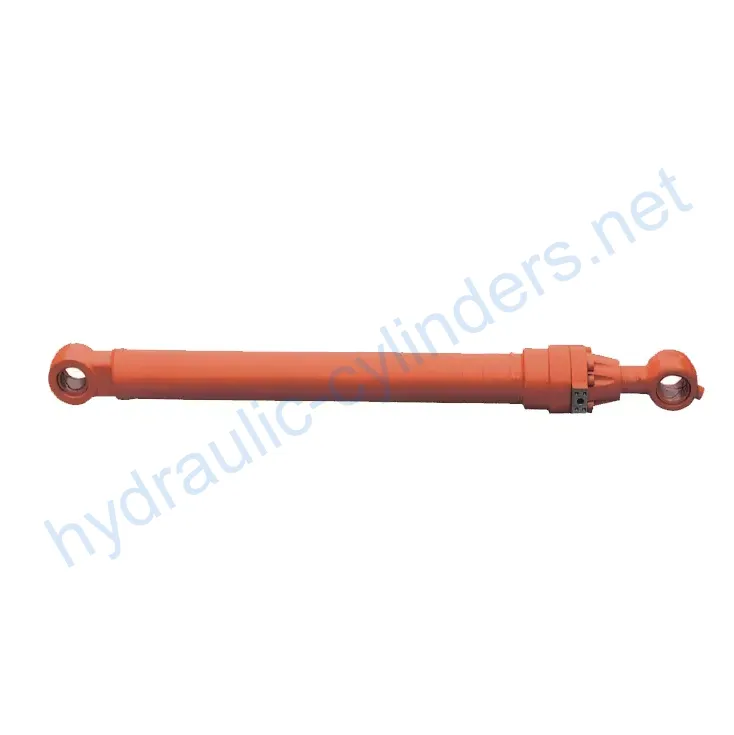Bucket Cylinder For Kato Small Excavator HD800-7
Introduction
A bucket cylinder is a specially designed hydraulic cylinder used to control the movement of buckets in heavy machinery, such as excavators, backhoes, and front loaders. Its main function is to enable the bucket to lift, lower, and tilt, making it ideal for a variety of material handling tasks. In a hydraulic system, the bucket cylinder achieves precise control of the bucket by varying the pressure of hydraulic oil, allowing operators to handle heavy loads efficiently and adapt to complex working environments and diverse operational needs.
Features
- High Strength and Durability: Typically made of high-strength steel or aluminum, the bucket cylinder can withstand high pressure and heavy loads, adapting to harsh working environments. Its design takes into account wear resistance and corrosion resistance to extend its service life.
- Efficient Hydraulic Operation: By using the pressure of hydraulic oil to achieve smooth extension and retraction, the bucket cylinder can respond quickly to control commands, providing powerful pushing and pulling forces suitable for handling heavy loads and complex tasks.
- Various Types: The bucket cylinder can be a single-acting cylinder (using hydraulic in only one direction) or a double-acting cylinder (using hydraulic in both directions) according to the operational needs. Some models are telescopic, allowing greater extension without increasing external dimensions, making them suitable for applications in limited spaces.
- Can Replace Other Hydraulic Cylinders: Our products are perfect replacements for other hydraulic cylinders, improving their performance and extending their service life.
- Wide Range of Applications: The bucket cylinder is widely used in construction equipment, agricultural machinery, excavators, backhoes, and front loaders. It is essential for excavating, loading, and moving soil or debris, lifting, digging, and dumping material, and other material handling tasks.
Design Considerations and Selection Criteria
The bucket cylinder’s design considerations include bearing capacity, sealing, durability, safety, and maintainability. The cylinder needs to support heavy loads while maintaining a high degree of precision in its operation. The sealing system must be secure and reliable, preventing leakage and ensuring long-term operation. The cylinder’s durability must withstand wear and tear, corrosion, and harsh environmental conditions. It should be easy to maintain and repair, allowing for quick replacement of parts and fast rebuilding when necessary.
Sealing and Lubrication
The bucket cylinder requires various sealing components, such as piston seal rings and rod seal rings made of wear-resistant materials such as polyurethane and nitrile rubber. The cylinder body and threaded end surface undergo fine processing to enhance wear resistance. Regular addition of suitable hydraulic oil is necessary for lubrication.
Maintenance and Repair
Regular inspections and preventive maintenance measures such as lubrication, sealing replacement, and calibration checks are essential for the bucket cylinder’s optimal performance. Correct installation, lubrication, and adjustment are crucial. Proper alignment guidance during installation, the use of appropriate installation brackets to secure the cylinder, and recommended inspection, repair, and replacement procedures can improve the cylinder’s service life.
Safety and Environmental Considerations
When using the bucket cylinder, it is crucial to follow safety measures to avoid accidents, such as wearing protective gear, ensuring the hydraulic system’s pressure is within the recommended range, and avoiding overloading the cylinder. Proper disposal of hydraulic oil and damaged components can minimize environmental impact.
Troubleshooting and Common Issues
Some common problems in bucket cylinder performance include leakage, insufficient force, and instability. Proper maintenance, inspection, and calibration can reduce such issues. If problems occur, diagnostic steps such as checking for loose connections, damage to the cylinder body, and wear to the sealing components can help identify the root cause. Replacing damaged components and rebuilding the cylinder can resolve most issues.
About Our Company
We are a manufacturer of replacement hydraulic cylinders, offering a complete range of products and services to become one of the leading manufacturers and wholesale distributors of hydraulic cylinders in domestic and international markets. We follow the principle of excellence in quality, relying on industrial production management strategies in sophisticated manufacturing workshops, employing technological talents, employing digital high-end manufacturing equipment, and a professional detection system to continuously improve the manufacturing platform and improve product quality production routes. We have strong creation capabilities and can meet customers’ diverse needs with high efficiency, high precision, and high quality.
- Professionalism: We have a team of experts and technicians with extensive experience in hydraulic cylinders, ensuring that our products meet the highest standards of quality and performance.
- International Certification: Our products have passed international certifications such as CE, ISO9001, and RoHS, ensuring their quality and safety.
- Customization Services: We offer customization services to meet specific needs and requirements, ensuring that our products are tailored to meet unique needs.
- Production Equipment: We use advanced production equipment, including CNC lathes, machining centers, and hydraulic cylinder test benches, to ensure that our products meet the highest standards of quality and performance.
- After-Sales Service: We offer comprehensive after-sales services, including installation guidance, maintenance and repair, and parts and rebuild services, to ensure our customers receive the best possible service.
Author: lyl

